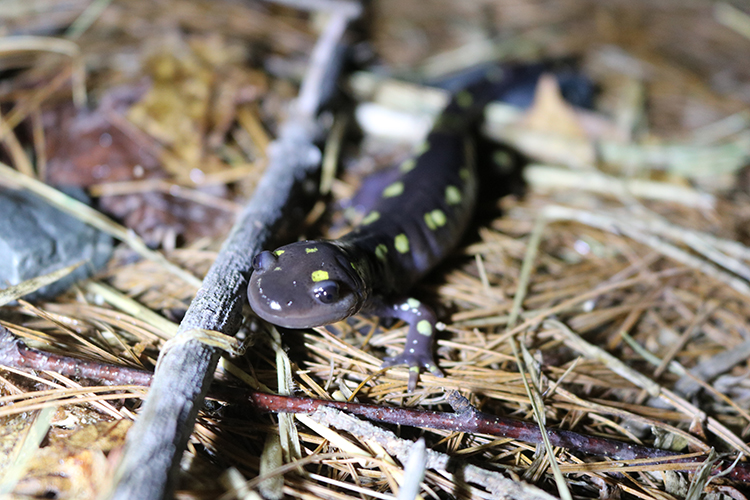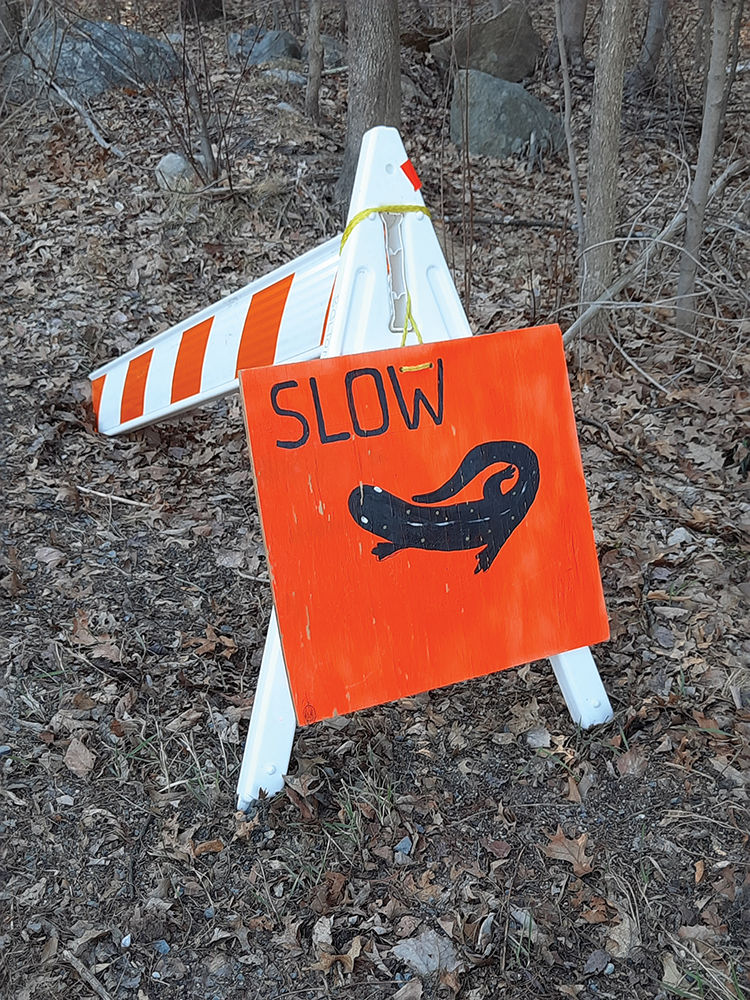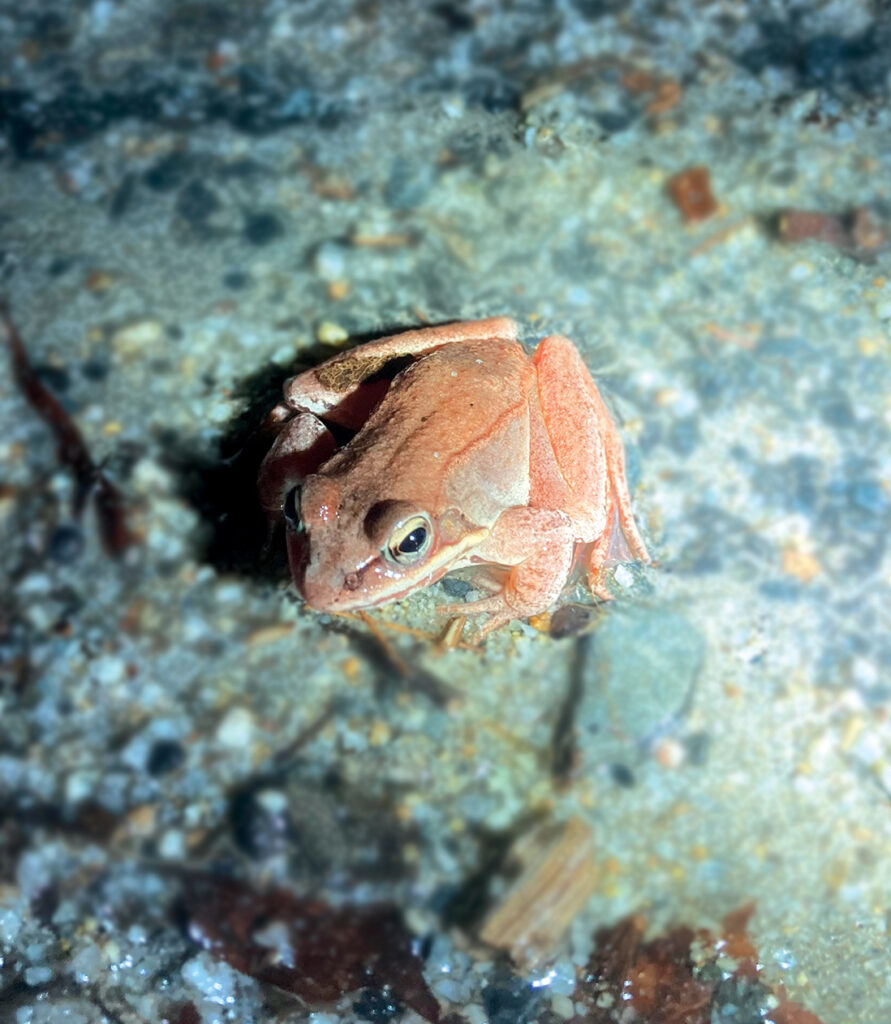March 25 Update: After the printing of this week’s edition, the weather forecast changed – moving Big Night expectations up from previous predictions. There was enough rain from Wednesday, March 24 overnight into early Thursday morning to allow for frogs and salamanders to travel. We’ll have an update about this year’s amphibian numbers in the coming days.

Published in The Bolton Independent March 24, 2021

Photo courtesy Joan Finger
By Kristin DeJohn
It’s become an annual spring tradition. Bolton naturalist Rona Balco gets the road signs and volunteers ready and they wait for ‘Big Night,’ the annual migration of salamanders and frogs from their wintering habitat to their vernal pool breeding grounds. The volunteers, aiming to limit amphibian roadway casualties, set up signs to alert motorists and bring buckets to help the slower salamanders cross.
While there were frogs and salamanders moving during the last rainy night, temperatures were on the low side. Balco says ideally they migrate when the temperature is above 45 degrees, so she predicts this week’s next forecasted rain may prompt more activity. Still, she is hesitant about expectations and admits she’s discouraged by what she’s witnessed in recent years.
“I didn’t see many egg masses last year,” Balco lamented. “I am not seeing the numbers I used to. Several years ago we had a lot of movement. Golden Run used to be a wonderful place and it was prolific and now it’s hardly anything. It’s very disheartening.”
Balco says the traditional Big Night often turns into various smaller nights and points to climate change as altering migration timing. “It’s getting earlier and earlier,” she noted. “It used to be mid-April.” She’s also concerned with motorists who ignore signs. “Some people just drive right through; they don’t have any consideration,” she said. “It seems one night a year they could be a little bit more cautious, but apparently salamanders are not that useful to them.”
Saving salamanders
Environmental scientist Jonathan Shuster, a natural resources project manager at SWCA Environmental Consultants, regularly assesses vernal pools. He recently moved to Bolton, joined Balco in surveying the area, and points out that the threat to salamanders goes beyond just having shorter legs and a harder time crossing roadways than frogs.
“Species like spotted salamanders are much longer lived (estimated 20-30 years) than wood frogs (estimated 3-5 years) and thus may be less able to bounce back from significant adult mortality given the longer life cycles and reproductive strategies involved,” he noted.
Currently, various salamander species found in this area are experiencing population declines. The marbled salamander is ‘threatened’ in Massachusetts, the blue-spotted salamander is listed as a ‘species of special concern’ and salamanders, in general, face a variety of threats.
“Population declines can be multifaceted,” explained Shuster. “Certainly habitat fragmentation and loss, including critical forested upland habitat adjacent to vernal pools, is a factor. Combine that with road mortality, climate change, increased environmental pathogens, along with direct impacts to vernal pools, and certain amphibian populations may no longer be sustainable.”
The climate threat
Salamanders have been referred to as the ‘canary in the coal mine’ for wetlands. Their skin is highly porous making them susceptible to chemicals. They rely on multiple habitats, making them sensitive to even slight ecosystem changes, such as changing weather patterns and water levels.

Photo courtesy Jonathan Shuster
Salamanders and frogs rely on vernal pools which are formed in the spring by rain and melting snow, and evaporate in summer. Unlike year-round ponds or lakes, vernal pools don’t support the fish that eat frog and salamander eggs and larvae. A major concern is how climate change will affect these critical breeding areas.
“Some of the greatest impacts of climate change may be increased irregularity of precipitation, drought, as well as changes in temperature, which can all impact the hydroperiod of vernal pools,” said Shuster. “When pools dry up quicker that leaves less of an opportunity for larval amphibians to successfully develop or promote earlier metamorphosis with smaller body size at emergence.”
Shuster says keeping good data over long periods of time and limiting construction or landscaping near vernal pool areas is critical. “You won’t be seeing that spotted salamander breeding in the wetland if the mossy log it lives under 200 feet away for most of the year is replaced with a lawn,” he noted.
Taking Action for Amphibians
Massachusetts does have the Wetlands Protection Act and many towns, like Bolton, have passed bylaws that protect land within 100 feet of a wetland – a buffer many consider limited in scope. “Conservation commissions should consider development in proximity to vernal pools carefully and at the very least make sure best management practices are implemented to minimize impacts to wetlands and vernal pools,” said Shuster.
Leaves and logs provide a critical habitat. Residents can help by limiting chemical yard sprays and leaving natural forested areas on properties undisturbed.
Another important way to help: limit driving on rainy nights in early spring, which are likely to be busy migration nights. In Bolton, watch for salamander crossing signs around the areas of Sugar Road, Corn Road, Golden Run Road, Harvard Road, Green Road and Nourse Road on the next rainy night. Monitor your own neighborhood for vernal pools and crossings. If you would like to be added to the Big Night volunteer list, call Rona Balco at (978) 779-2259.
For additional information:
https://www.townofbolton.com/conservation-commission
To report rare sightings: https://www.mass.gov/orgs/masswildlifes-natural-heritage-endangered-species-program
To learn more about vernal pools: https://www.vernalpool.org/